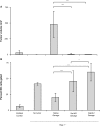Safety and immunogenicity of Salmonella typhimurium expressing C-terminal truncated human IL-2 in a murine model
- PMID: 20376175
- PMCID: PMC2846145
- DOI: 10.2147/btt.s9121
Safety and immunogenicity of Salmonella typhimurium expressing C-terminal truncated human IL-2 in a murine model
Abstract
Salmonella enterica serovar Typhimurium preferentially colonizes tumors in vivo and has proven to be an effective biologic vector. The attenuated S. enterica Typhimurium strain chi4550 was engineered to express truncated human interleukin-2 and renamed SalpIL2. Previously, we observed that a single oral administration of SalpIL2 reduced tumor number and volume, while significantly increasing local and systemic natural killer (NK) cell populations in an experimental metastasis model. Here we report that in nontumor-bearing mice, a single oral dose of SalpIL2 resulted in increased splenic cytotoxic T and NK cell populations that returned to control levels by 4 weeks post oral administration. Though SalpIL2 was detected in mouse tissues for up to 10 weeks, no prolonged alterations in peripheral blood serum chemistry or complete blood cell counts were observed. Similarly, comparative histopathological analysis of tissues revealed no significant increase in pyogranulomas in SalpIL2-treated animals with respect to saline controls. In Rag-1 knockout mice, which have severely impaired B and T cell function, SalpIL2 reduced growth of hepatic metastases. Furthermore, SalpIL2 altered expression of several proinflammatory cytokines and chemokines in the serum of mice with pulmonary osteosarcoma metastases. These data further suggest that SalpIL2 is avirulent and induces a cell-mediated antitumor response.
Keywords: Salmonella Typhimurium; interleukin-2; natural killer cells.
Figures







Similar articles
-
A phase I clinical study to evaluate safety of orally administered, genetically engineered Salmonella enterica serovar Typhimurium for canine osteosarcoma.Vet Med Sci. 2016 Jun 6;2(3):179-190. doi: 10.1002/vms3.32. eCollection 2016 Aug. Vet Med Sci. 2016. PMID: 29067193 Free PMC article.
-
Antioxidant oils and Salmonella enterica Typhimurium reduce tumor in an experimental model of hepatic metastasis.Onco Targets Ther. 2011;4:59-69. doi: 10.2147/OTT.S17081. Epub 2011 May 30. Onco Targets Ther. 2011. PMID: 21691578 Free PMC article.
-
Attenuated Salmonella typhimurium with IL-2 gene reduces pulmonary metastases in murine osteosarcoma.Clin Orthop Relat Res. 2008 Jun;466(6):1285-91. doi: 10.1007/s11999-008-0243-2. Epub 2008 Apr 18. Clin Orthop Relat Res. 2008. PMID: 18421536 Free PMC article.
-
Attenuated Salmonella typhimurium with interleukin 2 gene prevents the establishment of pulmonary metastases in a model of osteosarcoma.J Pediatr Surg. 2008 Jun;43(6):1153-8. doi: 10.1016/j.jpedsurg.2008.02.048. J Pediatr Surg. 2008. PMID: 18558199
-
Tumor-targeting amino acid auxotrophic Salmonella typhimurium.Amino Acids. 2009 Sep;37(3):509-21. doi: 10.1007/s00726-009-0261-8. Epub 2009 Mar 17. Amino Acids. 2009. PMID: 19291366 Review.
Cited by
-
A phase I clinical study to evaluate safety of orally administered, genetically engineered Salmonella enterica serovar Typhimurium for canine osteosarcoma.Vet Med Sci. 2016 Jun 6;2(3):179-190. doi: 10.1002/vms3.32. eCollection 2016 Aug. Vet Med Sci. 2016. PMID: 29067193 Free PMC article.
-
Antioxidant oils and Salmonella enterica Typhimurium reduce tumor in an experimental model of hepatic metastasis.Onco Targets Ther. 2011;4:59-69. doi: 10.2147/OTT.S17081. Epub 2011 May 30. Onco Targets Ther. 2011. PMID: 21691578 Free PMC article.
-
Inhibitory effects of the attenuated Salmonella typhimurium containing the IL-2 gene on hepatic tumors in mice.J Biomed Biotechnol. 2012;2012:946139. doi: 10.1155/2012/946139. Epub 2012 Oct 30. J Biomed Biotechnol. 2012. PMID: 23193368 Free PMC article.
-
Salmonella typhimurium mediated delivery of Apoptin in human laryngeal cancer.Int J Med Sci. 2013 Sep 21;10(12):1639-48. doi: 10.7150/ijms.6960. eCollection 2013. Int J Med Sci. 2013. PMID: 24155656 Free PMC article.
-
Co-Expression of a Chimeric Protease Inhibitor Secreted by a Tumor-Targeted Salmonella Protects Therapeutic Proteins from Proteolytic Degradation.J Microbiol Biotechnol. 2018 Dec 28;28(12):2079-2094. doi: 10.4014/jmb.1807.08036. J Microbiol Biotechnol. 2018. PMID: 30661346 Free PMC article.
References
-
- Horner MJ, Ries LAG, Krapcho M, et al. SEER Cancer Statistics Review, 1975–2006, based on November 2008 SEER data submission, posted to the SEER Website, 2009 Bethesda, MD: National Cancer Institute; 2009. Available from: http://seer.cancer.gov/csr/1975_2006/ Accessed on December 10, 2009.
-
- Ferguson WS, Harris MB, Goorin AM, et al. Presurgical window of carboplatin and surgery and multidrug chemotherapy for the treatment of newly diagnosed metastatic or unresectable osteosarcoma: Pediatric Oncology Group Trial. J Pediatr Hematol Oncol. 2001;23(6):340–348. - PubMed
-
- Longhi A, Errani C, De Paolis M, Mercuri M, Bacci G. Primary bone osteosarcoma in the pediatric age: state of the art. Cancer Treat Rev. 2006;32(6):423–436. - PubMed
-
- Bermudes D, Low B, Pawelek J. Tumor-targeted Salmonella. Highly selective delivery vectors. Adv Exp Med Biol. 2000;465:57–63. - PubMed
-
- Soto LJ, 3rd, Sorenson BS, Nelson BW, Solis SJ, Leonard AS, Saltzman DA. Preferential proliferation of attenuated Salmonella typhimurium within neuroblastoma. J Pediatr Surg. 2004;39(6):937–940. discussion 937–940. - PubMed
Grants and funding
LinkOut - more resources
Full Text Sources
Other Literature Sources

